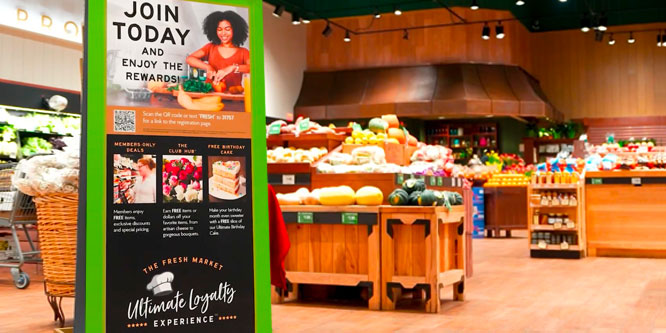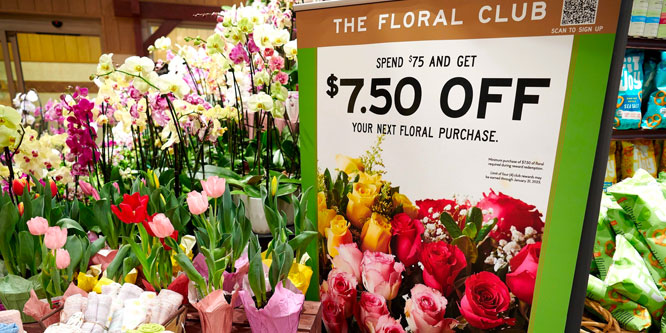
Photo: The Fresh Market
Will Fresh Market’s ‘club hub’ frequent purchase program drive loyalty?
It’s common to see grocers and food establishments with a “Buy 10 sandwiches get one free” program, or the like. As part of its first loyalty program, The Fresh Market is introducing not one but five purchase frequency programs.
The grocer’s “The Club Hub” programs include:
- Patisserie Club: Spend $75 on patisserie items, get $7.50 off your next patisserie purchase;
- Artisan Cheese Club: Spend $75 on artisan cheese, get $7.50 off your next artisan cheese purchase;
- Whole Panini Club: Buy 10 whole paninis, get your 11th whole panini free;
- Floral Club: Spend $75 on floral, get $7.50 off your next floral purchase;
- Coffee by the Cup Club: Buy 5 coffees, get your 6th free.
The current Club deals run through June 30. Afterwards, some offers may change based on interest and input from customers. The regional grocer, based in Greensboro, NC, said in a statement, “Loyalty members will have the opportunity to help pick the next club — the most in demand request may become the next purchase frequency club making this the customized loyalty program that guests have been asking for.”

In addition to The Club Hub frequency programs, which range across locations, The Fresh Market will make localized frequency club offers available, such as a Wine Club across its Florida stores and a Little Big Meal Club at its three stores in Boca Raton. The grocer said, “The ability to customize and create frequency programs to meet guests’ needs down to the store level is another unique member benefit.”
The Fresh Market’s program, called the “Ultimate Loyalty Experience,” also includes member-only offers and a free slice of cake during the member’s birthday month.
Kevin Miller, chief marketing officer at The Fresh Market, said, “We are thrilled that our Ultimate Loyalty Experience has been custom built from the ground up.”
Beyond also offering personalized offers, many other grocers’ rewards programs focus on rewarding points for overall purchases. The points can be redeemed toward future grocery purchases or gas. Many play up surprise awards, such as Harris Teeter’s weekly member-giveaway of at least $100 in groceries. Wegmans’ Shoppers Club program sends personalized digital coupons based on past purchases and frequency.
- The Fresh Market Launches The Ultimate Loyalty Experience – The Fresh Market
- The Ultimate Loyalty Experience – The Fresh Market
- Kroger REWARDS Debit Card Benefits – Kroger
- E-VIC BENEFITS – Harris Teeter
- Points Club Rewards – H-E-B
- Albertsons just for U – Albertsons
- GO Rewards – Stop & Shop
- Shoppers Club – Wegmans
Discussion Questions
DISCUSSION QUESTIONS: Will The Fresh Market’s rewards program tied to purchase frequency deals likely hold more appeal and be more effective than points-for-all-purchases programs? How would you rate the benefits and drawbacks of purchase frequency programs?


Way too complicated – they are going to make the shopper work way too hard just to understand what’s going on.
There’s a lot going on with this program for shoppers to keep track of, points for purchase is so much easier.
I like that the stores can customize the program to meet local needs, but I am also thinking about the people who are just about to receive an offer when the program abruptly changes. They are not going to be happy. Bottom line: I think it’s a good, but complicated program that’s a lot for shoppers to remember.
Customer loyalty is considered the Holy Grail of marketing. It’s proven that keeping current customers buying is critical for business success. However while we as marketers desire to secure consumer loyalty, customer behavior is often impulsive and fickle. Offering targeted purchase frequency programs can help move the needle on retail categories that need a short-term bump. Programs like this – as long as they don’t become endemic to the retail experience – can offer pronounced benefits until a certain degree of repetition has been achieved.
The five Cub Hub frequency rewards programs are very lucrative for the five product categories. However it seems much more complicated than “points for all purchases” loyalty programs. Personally I like the points for all purchases approach, but frequent purchasers of specific categories may like the product specific rewards as they can track their progress to the rewards.
Ok, I get the program and deals, but what if I don’t like the product category and really do not want more of it? Why not offer me points I can use for whatever I want? Nobody loses with that program.
I actually like the specificity of this, but I hope these ideas were data-backed. If these are categories shoppers have a history of zero interest in, using loyalty solely to create business (versus reward and retain) is a losing strategy.
This design is a solid approach offering value to shoppers and driving category purchase in areas of the store where margin is best. Fresh Market as a high-quality specialty store chose to launch with a simple to understand construct – assuming they commit to merchandising it in-store, train associates to reinforce the benefit and call out the savings when threshold is achieved and so on. Adapting by geographic location is a smart move as well. Coffee, fresh fish and deli are next up.
I love the idea of customizing rewards programs but this seems overly complicated and the benefits don’t feel compelling enough for customers to embrace the programs.
This is an interesting program design. Frequency is key and these parameters allow members to get to rewards quickly. Importantly for the retailer, customers are likely to buy more items than just those within the selected categories – and therefore, they are increasing revenue without the cost of points in non-category products. The challenge I see is communicating the program characteristics in a way that customers will remember. This could be challenging if there are three to five clubs running at a time, several of them might end in three to four months so others can be started. Of course, the categories mentioned are much higher margin goods than most grocery items, so they can afford to be generous. I will be interested in monitoring how this evolves – but focusing on frequency over total spend is what made Walgreens such a star back in the 1980s and part of the 1990s.
Points for purchase loyalty programs are fine. But if they were that effective, I presume that’s all anyone would do. Also, points programs don’t drive any real loyalty. Just repeat purchase. Good to see some testing and learning.
My favorite line of the overview is “The current Club deals run through June 30. Afterwards, some offers may change based on interest and input from customers.” I hope they follow through on that – engage with consumers to understand what they do and don’t like about this new structure.
This is an interesting approach. My first thought is wow, this is complicated. Just reward them for all their purchases and you’ll get the same result. I also know, especially in grocery, that certain brands have different levels of loyalty by category. Personally I shop at three different grocers. One for meat and occasional produce. One mostly for produce, dairy and bulk foods, and one for general merchandise. I don’t think I’m an outlier. This scheme might allow Fresh Market to really target shoppers in specific category and drive incremental purchases in those categories?
It’s a test, I like that they’re telling their members that it’s a test, so if it changes they’re prepared. It will be interesting to see how it works.
First, this is not a loyalty program. It’s a rewards program, and the reward is a discount of 10 percent in these five areas. In other words, it’s marketing. Nothing wrong with that if it drives sales, some repeat business and makes members of the program feel connected, which is getting closer to true loyalty.
Some may disagree with me about loyalty programs versus marketing programs. The outcome looks the same in that customers come back. However if you take away the perks (rewards/discounts), do the customers keep coming back? True loyalty is about customers coming back, regardless of a discount, price, points, perks, etc.
Let’s see — if I regularly shop those five categories, then you are giving me a discount I didn’t ask for, and the odds are my purchase patterns won’t change. On the other hand, if I don’t regularly shop those categories is it really because of price or is it maybe I just don’t see much value in artisanal cheeses? The net effect of all price-based “loyalty” programs is to reduce margin by rewarding people for regular purchases. Worse, customers who do not participate for whatever reason – say data privacy concerns – assume (in this case 100 percent correctly) that they are getting gouged on price. The article calls this a “loyalty” program. Only one problem, loyalty can’t be bought — it has to be earned. And the only way to do that is to know the customer well and offer them something special that is meaningful to them on their terms. Somehow a free cup of coffee doesn’t seem to fit that bill.
The objective must be “let’s confuse our customers.”
If you want me to be loyal, make it EASY.
Gene, what fun would that be?
I get the distinct feeling that the Fresh Market loyalty program is designed to drive what’s important to Fresh Market, not their shoppers. I literally shop Fresh Market six times per week — and have felt very little benefit from entering my phone number into the POS. It’s only a matter of time before shoppers skip those keystrokes if no value results.
Well, there are transactional approaches to loyalty and there’s this, which is exactly the same thing. While there will be relevance for the discount for those concentrating in the various categories, it would be more rewarding to allow customers to mix and match, especially given that the spend thresholds and discounts are similar. No soft benefits, just hard savings. That alone will not drive anything but transactional loyalty and that’s easily usurped by others. Terrible tag line too, in “the ultimate loyalty experience.” This is far from an experiential program, other than transactionally.
All that said, customers love discounts so for some, it will be good. Hopefully the margin trade off shows generative transactions — in terms of incremental spend and frequency — as a result.
The Fresh Market likes to be seen as different, and they’re doing it again with their new loyalty program. As a regular Fresh Market shopper, it seems to complex and specific to really get me interested. I get that they don’t want a generic “discount or points” program like so many other grocers, but they’ll need to find the right combination of value and ease of use to motivate shoppers to participate.